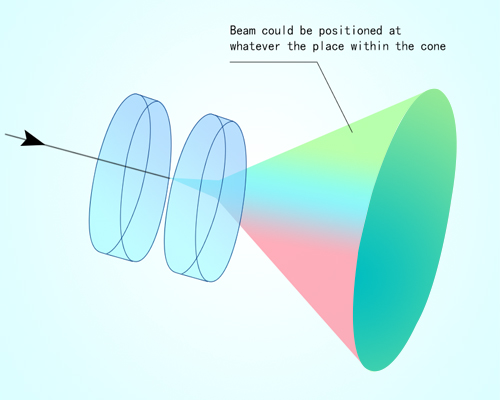Specifications:
| Material | UVFS, N-BK7, CaF2, MgF2, ZnSe, etc. | Design Wavelength | K9:632.8nm,n=1.515@632.8nm UV Fused Silica:355nm,n=1.476@355nm |
| Dimension Tolerance | +0/-0.1mm | Surface Quality | 20/10 S/D |
| Thickness | Custom | Clear Aperture | >90% |
| Flatness | <λ/10@632.8nm | Wedge Angle Tolerance | <30 arc sec |
| Deviation Angle | 1°-10° | Coating Options | Uncoated, V-Coating, BBAR Coating, or Custom |
A Wedge Prism is an optical component with a shallow angle between its input and output faces. Wedge prisms are excellent for laser beam steering applications, as the oblique side and flat side permit the wedge prism to deflect light towards the thicker portion of the prism with specific deflection angles. The larger the wedge angle, the greater the angle of deviation when light emerges from the prism. Furthermore, rotating the wedge prism about the optical axis is a great approach to obtaining circular laser beam scanning output. To make insertion into rotatable mounting more convenient, wedge prisms are often fabricated into circular shapes.
Wedge prisms could either be used as a single element or in pairs (in this case, the wedge prism pair could also be called a Risley Prism Pair). As mentioned above, a single wedge prism could be utilized to deviate a laser beam at a set angle or realize the tracing of a circular light path on the vertical plane. Wedge prisms in pairs can be used for anamorphic beam shaping (i. e. to correct the elliptical beams into circular ones in laser diodes). Besides, by spinning the two wedge prisms in conjunction at relative rotation speeds, one can attain an adjustable amount of light deflection, the exiting laser beam could be positioned in a random direction inside a cone that takes the incident beam as the center axis (i.e., laser scanning output with spontaneous beam profile are feasible). or, in other words, assume α is the light deviation from an individual wedge prism, a pair of Risley wedge prisms can steer a beam in whatever place within a circle defined as the angle 4α.
Hangzhou Shalom EO offers Custom Wedge Prisms made from various materials including N-BK7. UV Fused Silica, CaF2, MgF2, ZnSe, etc. offering 1-10° light deviation. Coating options include uncoated, V coating, Broadband Anti-reflection coating, and other custom coatings, which could be furnished at the wedge side or the flat back side to attenuate the disturbance from the ghost image resulting from surface reflection. Shalom EO is consistent in investing in developing cutting-edge technologies aimed at fostering a strengthful production line. We are capable of presenting high-precision wedge prisms with <λ/10 flatness, <30 arc sec angular tolerance, and +0/-0.1mm dimension tolerance. In addition, we also provide Stocked Wedge Prisms in another catalog, click on the bold text to learn more.
Application Notes:
1. Wedge Prism could either be used as a single element or in pairs. Operating alone, wedge prisms could be used for beam steering, where the extent of angular deviation is often slight. ( See Figure 1. below). A single wedge prism might also be installed in a rotatable mount so that through rotating the wedge prism about the optical axis, a circle traced using the deviated beam could be formed.

Figure 1. Illustrates how a wedge prism accomplishes beam steering.
2. If one is to use wedge prisms like use Wedge Prism Pairs or Risley Prism Pairs, then the wedges of the prisms must be aligned to the home position where the thicker sections are vertical. Activate the rotatable mount, as long as the wedge prisms are spun with the same speed and in the same direction, the circle traced out will have a radius that is twice as great as that of the circle in the case of the single wedge prism.

Figure 2. Shows the circular laser scanning output realized using a pair of wedge prisms.